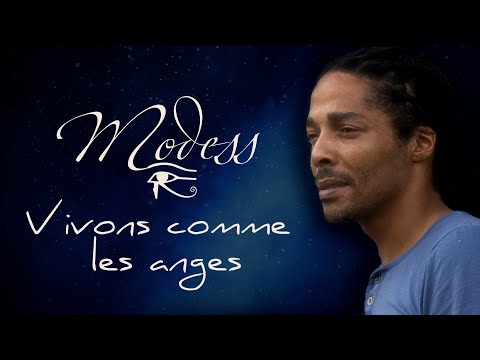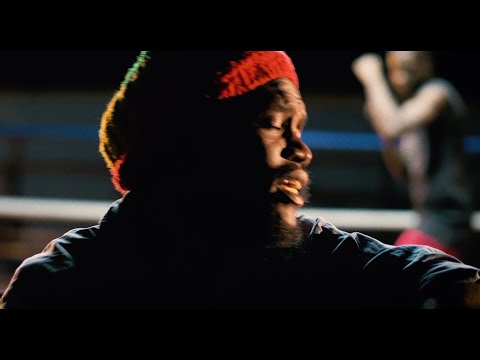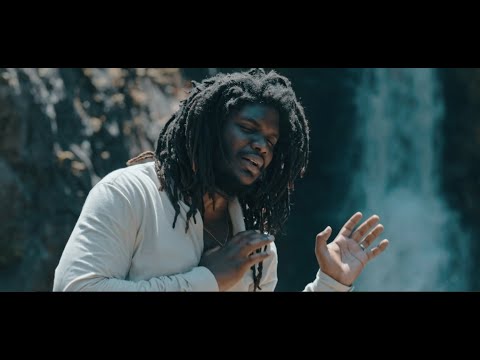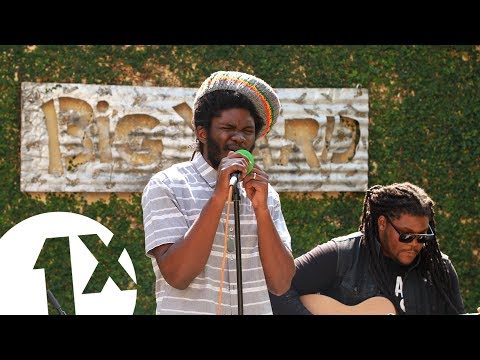Articles about reggae music, reviews, interviews, reports and more...
Bob Marley and the Seven Chakras

Bob Marley and the Seven Chakras
In her book The Anatomy of Spirit, Caroline Myss outlines the seven chakras of the human body. According to Eastern tradition, these archetypal power points represent a form of “symbolic sight”, which Geoffrey Philp has found useful in tracing Marley’s career.
For many, the name Bob Marley conjures up the caricature of a party-going, ganja-smoking Rastaman. For others, it evokes the image of a freedom fighter, dedicated to peace and brotherhood. During his brief but intense career, Marley was both. Even now, many years after his transition, his music is known and appreciated by people who couldn’t name another reggae musician if they had to. Perhaps that’s because Marley was more than just a pop singer. By the time cancer claimed him at the age of thirty-six, he had become a shaman whose medium was song. A devout Rastafarian whose faith cost him his life** - he refused surgery in order to keep his body, his temple, intact on his way to meet Jah (the Rastafarian name for God) - Marley used reggae as a means of proselytizing the unconverted. Through his restless devotion to his art, he transformed the pop medium of reggae into a means of conveying the timeless truths of humanity. But Marley was not born a Rastaman, and his growth from a scrappy street fighter to a peace-loving Rastaman follows the pattern of many mystics who preceded him.
In her book The Anatomy of Spirit, Caroline Myss outlines the seven chakras of the human body. According to Eastern tradition, these archetypal power points represent a form of “symbolic sight”, which I have found useful in tracing Marley’s career. They represent also a sort of spiritual shorthand to the power centers or challenges that every human will face: survival, sexuality, power, love, self-expression, wisdom or ignorance, and the acceptance of grace. These are universal issues: “There’s a natural mystic blowing through the air/ If you listen carefully, you will hear…/Such a natural mystic/ Blowin’ through the air,” (“Natural Mystic’). Marley accepted his role as a “natural mystic”, and would no doubt appreciate the correspondence the chakras. It is also worth noting that Marley belonged to the Rastafarian, Twelve Tribes of Israel - he belonged to the tribe of Joseph (See jacket cover of Rastaman Vibration LP) and in one concert (Legend DVD), he reminded his audience, “When you say Judah, you must touch the heart” - for each tribe had a function (state of being that had zodiacological origins/state of consciousness/ physiological centers), and Judah corresponded to the heart.
Whichever pattern you believe, the power behind our lives that the poet Dylan Thomas describes as, “The force that through the green fuse drives the flower,” is experienced on an intense level in the lives of these shamans/mystics (who are willing to open up to the experience) and propels that desire for one-ness/at-one-ment/connection to the divine that is expressed as Sahasrara, Kether, or Jah-Rastafari*, and often begins with what the psychologist Maslow calls, “an oceanic moment” or if you are a Catholic as an epiphany.
We all have different names for these states of being (and I know this is heresy to the true believers), but if as Campbell suggests that these states of consciousness are rooted in our biology - there is only one human central nervous system - then we can reasonably assume a certain similarity in the variety of human experiences for the chakras speak to experiences that are common to the human race. For sooner or later, we will all have to confront with our relationship to our tribe: Muladhara / Survival / Tribal Power (What is my relationship to my tribe? Who are the members of my tribe? Will I be limited by the perceptions of my tribe? How will I survive?); Sexuality / Svadisthana (How does wholeness and holiness fit in to this when I am so divided (mind/body split), and my sexuality makes me grasp for someone outside myself? How does my sexuality/creativity fit into the pattern of my life?); Manipura / Power (Will I use my power/gifts/talents for my own ego concerns or will I use my power to help even those who are outside my tribe?); Anahata / Compassion (Am I really one with you?); Vishuddha / Surrender / Self-Expression (Is the universe hostile or benign? Is “every little thing gonna be all right”?) Ajna / Wisdom / Intuition (What is the truth of this situation? How does my truth balance against these other truths?); Sashara / Grace (How do I make every moment a moment of total acceptance and awareness?).
Sometimes, depending on the level of our meditation, we get a glimpse of that oneness—a feeling that the mystics/shamans tell us they experience every day: or as Bob would say, “The brotherly love, the sisterly love, I feel this morning,” (“Top Rankin”) and his life was livicated to the relentless self-inquiry (Dawes 191) that these questions and states of being lead us to ask.
Like an ancient medieval alchemist, Bob lifted up (tikkun olam) carnal emotions (lead) and transmuted them into psalms of praise (gold). The difference between artists/mystics and the rest of us is not the raw material (we all have these power points/chakras), but their willingness (fearlessness?) to be open to new experiences and their transformation their woundedness into praises of joy.
From his earliest days as a rude boy in Trench Town, Marley recognized his community as his primary source of identity (Muladhara). Joseph Campbell’s Transformation of Myth Through Time defines this as, “land claiming… through naming the landscape, you read the land that you are living in as the holy land.” Bob returned to Trench Town many times to pay tribute to the place where he spent his formative years. “Trench Town Rock” (released in 1970) was the earliest indication of Bob’s land naming. Although Trench Town was and is one of the most wretched ghettos on the globe, Marley loved the people of Trench Town and pleaded for them: “Trench Town rock, give the slum a try / Trench Town rock, never let the children cry” (“Trench Town Rock”). Despite the deplorable conditions, Bob recognized the strength of community and loved and respected his origins: “They say can anything good come out of Trench Town? / That’s what they say, Trench Town / They say we’re the underprivileged people / So they keep us in chains / Pay, pay, pay, pay tribute to Trench Town / We come from Trench Town” (“Trench Town”). Intuitively, he knew the value of an old Akan saying: “Only a fool points at his origins with his left land.”
“You have to sing love songs”, said Bob Marley in a 1981 interview with Dermot Hussey (Talking Blues), and sing them he did. The second chakra, Svadisthana, represents sexuality and creativity. Campbell explains, “Sex is the aim of life. Everything is coming up roses. The birds are singing. The bells are ringing for me and my gal.” Pop music rarely rises above this level, and in songs such as “Kinky Reggae”, “Mellow Mood”, “Do It Twice”, and “Put It On,” Marley proclaims the joy of sex and procreativity. “Come rub it on my belly like guava jelly,” he croons in “Guava Jelly.” And “Stir it Up” is a lyrical celebration of sex filled with double entendres: “I’ll push the wood, I’ll blaze your fire / Said I’ll satisfy your heart’s desire.”
Bob loved women and weed. On Kaya (also Rastafarian for marijuana), Bob acknowledges the power of the weed and its effect on his creativity: “Excuse me while I light my spliff / Oh, God, I gotta take a lift / From reality I just can’t drift / That’s why I’m staying with this riff” (“Easy Skanking”). In Awakening the Heroes Within, Carol S. Pearson asserts that magicians are naturally attracted to hallucinogenic drugs such as marijuana (19). Maybe that is why Bob Marley celebrated it in song and made it part of his life. Or maybe it was a means of lessening the blows (of which he was painfully aware) to his self-esteem and personal honor.
Throughout Africa and the Third World, Bob is revered for his warrior status and no-nonsense stand on human rights. “Get Up, Stand Up” has become the anthem for Amnesty International. “I Shot the Sheriff”, and “Crazy Baldhead” are perfect examples of Manipura, the third chakra, “the will to power”. From his earliest days in Trench Town, Bob was known as a street fighter and earned the names “Tuff Gong” and “Hammer” (White 319). “If you are a big tree,” sings Marley in a perfect mixture of Rastafarian mythology and King James Bible lyricism, “we are the small axe” (“Small Axe”). Bob extended his sense of personal dignity to his community, his race, and ultimately the whole human tribe: “Every man got a right to decide his own destiny” (“Africa Unite”). It was this constant pushing against his limitations and weaknesses that led Bob to the fourth chakra, Anahata.
Joseph Campbell clarifies, “Anahata refers to the sound that is not made by two things striking together… Om…this is the Virgin Birth, the level of humanity that recognizes love as a divine power and is open to forgiveness, compassion, hope, and trust (Myth 219). Is it any wonder then why so many people around the world are drawn to “No Woman, Nuh Cry”? Set in Trench Town, Bob draws his mother, his sisters, and his friends—all of us—into a circle of grace and love, speaking to us in our deepest moments of existential terror, almost in a lullaby: “Everything’s gonna be all right.” Bob turned all the energies of the second chakra into a universal embrace of the divine.
“Not my will, but thy will” is the hardest challenge for anyone (especially an artist like Bob who fought for recognition all his life) to face and acknowledge, yet Bob was willing to give up many things, such as the acceptance of the tribe (“Unconcerned with the good opinion of others”), to make divine music. He was willing to move from loving to being loved, opening himself up to a sort of second birth to the true life—a personal surrender to the divine by following his dream and his destiny. This is the task of chakra five, Vishuddha (“purified”). Bob sensed this intimately and changed the lyrics of “Put It On”, from “I rule my destiny,” to “Jah rules my destiny” in his live performances (Legend)
Marley’s destiny was fraught with many challenges. As Joseph Campbell reminds us, “If what you’re following is your bliss, your passion—it’s so easy to tip over and fall into a torrent of passion that sweeps you away” (Myth 285) Passion can also lead to despair. At level six, Ajna, the Search for Truth, Bob sang some of his saddest songs: “Natural Mystic,” “Johnny Was,” “Time Alone Will Tell,” “War,” and “Concrete Jungle” are a few. The most harrowing of these, “Concrete Jungle”, describes the “dark night of the soul” in a contemporary urban setting: “Darkness has covered my light / And has changed my day into night / Oh where is the love to be found? / Won’t someone help me ‘cause I’ve got to pick myself from off the ground.”
The feelings of woundedness, feelings of unworthiness over one’s past, guilt that others (especially close friends and family) have not achieved a sense of equilibrium, afflicts the seeker at this point. Bob was no exception, and it drove him into exile from his homeland. He left Jamaica on self-imposed exile because of death threats and the noise that surrounded his life. He would return occasionally, “Coming in from the Cold”, but his life at this point belonged to humanity and he had accepted an expanded view of his homeland.
Bob was aware of divine grace in his life. From this state of grace, Sahasrara, the seventh chakra, he lived his life in the present moment and sang, “Jah Lives”, “Give Thanks and Praises,” “Forever Loving Jah,” “Rastaman Chant,” and “Thank you, Lord.” The Christian sacraments call this extreme unction: the ability to bestow grace to finish one’s unfinished business.” And herein lies the real challenge that Bob’s life has left for us: “Won’t you help to sing these songs of freedom? / For all I ever had… redemption songs, redemption songs / Sing along with me children.” (“Redemption Songs”)
Bob’s lyrics remain stuck in the conscience of our race. He struggled to overcome two of the most intransigent problems of humanity—racism and poverty—and to transform the events of his life into a vision of wholeness and holiness. This Bob did with grace and love, always questioning, always pushing himself (and us in the process) to a higher definition of himself. There are some who point to Bob’s many flaws to denigrate his accomplishments, but Bob wrote and sang from the “higher man,”: “We are the children of the higher man”, “Africa Unite.” In the West African tradition, a griot/shaman doesn’t have to be “holy”—his sole responsibility is to sing the truth of his tribe. Bob accomplished this task. So many after his death, his words remain in the consciousness of humanity, just as they did during the Mid-East peace negotiations over what seems a lifetime ago: “Cause puss and dog they get together / What’s wrong with loving one another?” (“So Jah Seh”).
Bob Marley and the Seven Chakras
1. Muladhara: Tribal Power; Survival
“One Love”
“Trench Town”
“Africa Unite”
“Caution”
“Smile Jamaica”
“Survival”
“Zimbabwe”
“Trench Town Rock”
2. Svadisthana: Creativity / Sexuality;
“Guava Jelly”
“Soul Shakedown Party”
“Stir It Up”
“Craven A Go Choke Puppy”
“Simmer Down”
“Nice Time”
“Put It On”
“Kaya”
“Back Out”
“Sun Is Shining”
“Do It Twice”
“Mellow Mood”
3. Manipura: Honor Oneself; Self-esteem; Personal Honor; Power
“Small Axe”
“Judge Not”
“Get Up, Stand Up”
“Burnin and Looting”
“Natty Dread”
“Iron Lion”
“Duppy Conqueror”
“Soul Rebel”
“Hammer”
“I Shot the Sheriff”
4. Anahata: Love is Divine Power; Forgiveness and Compassion; Hope and Trust; Grief and Anger; Resentment and Bitterness
“Waiting In Vain”
“No Woman, No Cry”
“Is This Love?”
“I’m Still Waiting”
“Stir It Up”
“Bend Down Low”
“Could You Be Loved”
5. Vishuddha: Surrender Personal Will to Divine Will; Following One’s Dream; Self-Expression
“Judge Not”
“Mix Up, Mix Up”
“Ride Natty Ride
“Babylon System”
“Real Situation”
“Bad Card”
“Why Should I?”
6. Ajna: Seek Only Truth; Intuition
“Concrete Jungle”
“Natural Mystic”
“I’m Hurting Inside”
“Who the Cap Fit”
“Crazy Baldhead”
“War”
“Running Away”
“Johnny Was”
“Rat Race”
“Keep On Moving”
“Exodus”
“Time Alone Will Tell”
“Coming In From the Cold”
7. Sahasrara: Live in the Present Moment; Ability to Trust Life; Ability to see larger pattern; Faith and Inspiration; Spirituality and Devotion
“Give Thanks and Praises”
“Rastaman Live Up”
“Rastaman Chant”
“Lively Up Yourself”
“Thank You Lord”
“Jah Live”
“Three Little Birds”
“Redemption Song”
“Easy Skanking”
“Smile Jamaica”
“One Drop”
“Forever Loving Jah”
Sources: Marley, Bob. Songs of Freedom. CD. Island. 1992.
Myss, Caroline. Anatomy of Spirit. New York: Three Rivers, 1996.
Works Cited
Campbell, Joseph. Transformations of Myth Through Time. New York: Harper, 1990.
Campbell, Joseph. The Power of Myth. New York: Anchor, 1991.
Dawes, Kwame. Bob Marley: Lyrical Genius. London: Sanctuary, 2002.
Marley, Bob. Songs of Freedom. CD. Island. 1992.
Marley, Bob. Legend. DVD. Island, 2004.
Myss, Caroline. Anatomy of Spirit. New York: Three Rivers, 1996.
Pearson, Carol S. Awakening the Heroes Within. New York: HarperCollins, 1991.
White, Timothy. Catch a Fire: The Life of Bob Marley. New York: Holt, 1989.
Read more about this topic
Read comments (1)
| Posted by Rapinto Robert on 05.11.2011 | |
| JAH GUIDE N BLESS BOB MARLEY AS WE ALWAYS REMEMBER YA FOR DEM DEPARTURE FROM DE DIRT.... WE WILL ALWAYS LOVE U FOR IVA... | |
Comments actually desactivated due to too much spams
Browse by categories
Recommended Articles
Latest articles
Recently addedView all
© 2007-2025 United Reggae. All Rights Reserved. Reproduction in whole or in part is prohibited. Read about copyright
Terms of use | About us | Contact us | Authors | Newsletter | A-Z














